Social:Tripolitania Punic inscriptions
| Tripolitania Punic inscriptions | |
|---|---|
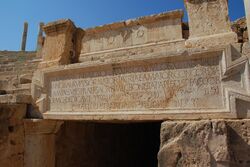 Bilingual inscription at Leptis Magna | |
| Writing | Punic |
The Tripolitania Punic inscriptions are a number of Punic language inscriptions found in the region of Tripolitania – specifically its three classical cities of Leptis Magna, Sabratha and Oea (Tripoli), with the vast majority being found in Leptis Magna. The inscriptions have been found in various periods over the last two centuries, and were catalogued by Giorgio Levi Della Vida. A subset of the inscriptions feature in all the major corpuses of Canaanite and Aramaic inscriptions, notably as KAI 119-132.
In addition to inscriptions in the Punic script, the corpus includes a number of Punic inscriptions written in Latin script, such as KAI 304-305.[1][2]
According to Karel Jongeling, 68 inscriptions are known from Lepcis Magna, 15 from Sabratha, 10 from Oea, 4 from Zaiuet el-Mahgiub, 3 from Wadi el-Amud, 2 from Germa and 1 each from El-Amruni, Gasr Doga, Bir Gebira, Bu Khemmàsc, Henchir Gen Rieime, Misurata Marina, Al-Qusbat, Ras el-Hadagia, Sàmet el-Crèma, Taglit and Tarhuna.[3]
Early discoveries

Prior to 1927, only eight Punic inscriptions from all of Tripolitania had been published.[4]
The first find was in 1806 by Jacques-Denis Delaporte at Leptis Magna, published in his 1836 memoir:[5]
I turned south and climbed the remains of the temple of Friendship. I had barely reached the mound when I set foot upon a hard stone. The foreign characters under the Latin characters engraved on it made this monument so precious in my eyes, that I have not hesitated to include a copy of the inscription... It is a shame that it is only a fragment, because it could allow clarification of Punic or Phoenician writing, which is, I believe, that of this inscription, because lingua punica quidquid terraram est à Cyrene usque ad Gades occupavit... The stone is still on the spot: I have not urged the Americans to seize it, because it suits France better, if it is deemed worthy of adorning the Napoleon Museum.[6]
Delaporte identified the language as Punic by reference to a quote from Samuel Bochart's 1646 work Canaan, which translates in full as: "...the language of Canaan, whether Phoenician or Punic, which was brought from Phoenicia into Africa, and occupied all the world from Cyrene to Gades."[7]
By 1857, Moritz Abraham Levy stated that five inscriptions were known.[8]
Later discoveries
For forty years between 1927-1967, Giorgio Levi Della Vida worked to prepare a corpus of the Punic inscriptions in Tripolitania, intended as the Punic parallel of Joyce Reynolds' and John Bryan Ward-Perkins' The Inscriptions of Roman Tripolitania (IRT). Levi Della Vida's corpus brought together research which has often appeared in periodicals that are not very accessible, sometimes defunct, and were not always accompanied by adequate photographic documentation.[9][10]
Concordance
| Image | Discovery date and location | Punic concordance | Latin (if bilingual) | Current Location | Other ref. | |||
|---|---|---|---|---|---|---|---|---|
| Tripolitania[11] | Iscrizione Puniche della Tripolitania | KAI, CIS, NE[12] | Levy 1857[13] | IRT[14] | ||||

|
1 | |||||||

|
9 | I1 | ||||||
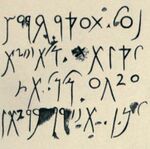
|
10 | NE 434, B-a | I2 | [15] | ||||

|
11 | I3 | ||||||
| 12 | I4 | 655 | lost[16] | |||||

|
13 | I5 | 654 | Red Castle Museum[17] | ||||
 
|
12 | 17 | KAI 130 | |||||
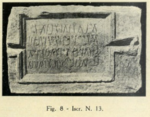
|
13 | 18 | KAI 129 | |||||

|
14 | 19 | KAI 131 | |||||
| 16 | 481 | |||||||
| 27 | 21 | KAI 120 | 319 | Leptis Museum | ||||
| 28 | 22 | KAI 122 | ||||||
| 29 | 23 | KAI 123 | Leptis Museum | |||||
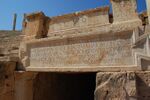 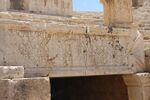
|
30 | 24a and 24b | KAI 121 | 321-323 | in situ | |||
| 25 | KAI 127 | 294 | ||||||
| 31 | 26 | KAI 124 | 338 | |||||
| 32 | 27 | KAI 126 | 318, 347 | |||||
| 34 | 29 | KAI 128 | ||||||
| 36 | 30 | KAI 125 | 305 | |||||
| 37 | 31 | KAI 119 | ||||||
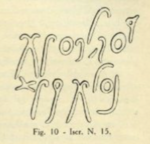
|
68 | KAI 132 | ||||||
| 1901, Breviglieri | 76 | KAI 118, RES 662 | [18] | |||||
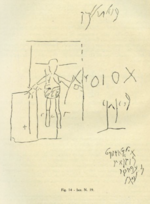
|
82A-K | |||||||

|
96 | |||||||
Other
- KAI 178 Leptis Magna Latino-Libyan [in LATIN]
Bibliography
- Levi Della Vida, 1927: Giorgio Levi Della Vida Le iscrizioni neopuniche della tripolitania, Libya (Rivista didella Tripolitania) 1 (III) 1927 91-116
- Levi Della Vida, 1935: Giorgio Levi Della Vida Due iscrizioni neopuniche di Leptis Magna, Africa Italiana 6 1935 3-15; 107-115
- Levi Della Vida, 1938: Giorgio Levi Della Vida Il Teatro Augusteo di Leptis Magna secondo le ultime scoperte e un'iscrizione bilingue in latino e neo-punico II, Africa Italiana 6, 3-4 1935 (published 1938) 104-109
- Levi Della Vida, 1942: Giorgio Levi Della Vida The Phoenician God Satrapes, Bulletin of the American Schools of Oriental Research 87 1942 29-32
- Levi Della Vida, 1949: Giorgio Levi Della Vida Iscrizioni neopuniche di Tripolitania, Rendiconti di Accademia Nazionale dei Lincei 8 1949 399-412
- Levi Della Vida, 1967: Giorgio Levi Della Vida Su una bilingue latino-punica da Leptis Magna, Atti dell'Accademia delle Scienze di Torino 101 1967 395-409
- Levi Della Vida, 1987: Giorgio Levi Della Vida and Amadasi Guzzo, Iscrizione Puniche della Tripolitania, 1987
- Barron, Caroline (2020-01-01). "Appendix: amator concordia, ornator patriae. The Latinisation of Punic titles in early imperial Lepcis Magna". Libyan Studies. doi:10.1017/lis.2020.7. https://www.academia.edu/44501495. Retrieved 2022-10-06.
References
- ↑ Goodchild, R. G. (2011-11-29). "The Latino-Libyan Inscriptions of Tripolitania - The Antiquaries Journal". The Antiquaries Journal 30 (3–4): 135–144. doi:10.1017/S0003581500087795. ISSN 1758-5309. https://www.cambridge.org/core/journals/antiquaries-journal/article/abs/latinolibyan-inscriptions-of-tripolitania/083F1821C02F3E6C2437956FAB39C192. Retrieved 2022-05-31.
- ↑ Charles R. Krahmalkov. “A Reinterpretation of the Neo-Punic Inscription IRT 889 from Roman Tripolitania.” Journal of the American Oriental Society, vol. 93, no. 1, 1973, pp. 61–64. JSTOR, https://doi.org/10.2307/600518. Accessed 31 May 2022.
- ↑ Neo-punic inscriptions from Libya
- ↑ Levy Della Vida, 1927, page 92: "Non è inopportuno rammentare quali siano le iscrizioni neopuniche della Tripolitania finora pubblicate: esse non superano, come è stato detto sopra, il numero di otto."
- ↑ Reynolds, J. M. “Some Inscriptions from Lepcis Magna.” Papers of the British School at Rome, vol. 19, 1951, pp. 118–21. JSTOR, http://www.jstor.org/stable/40310492. Accessed 9 Oct. 2022.
- ↑ Delaporte (1836) (in fr). Mémoire sur les ruines de Leptis Magna, régence de Tripolis de Barbarie: adressé en 1806 à M. le prince de Bénévent. Impr. roy.. pp. 13–14. https://books.google.com/books?id=hd8-AAAAcAAJ&pg=PA13. Retrieved 2022-10-06. "Je pris au sud et montai les débris du temple de l'Amitié. J'étais à peine arrivé sur la colline qu'ils forment, que je mis le pied sur une pierre dure. Les caractères étrangers placés sous les caractères latins qui y sont gravés ont rendu ce monument si précieux à mes yeux, que je n'hésite pas à en figurer l'inscription... Il est à regretter que ce ne soit qu'un fragment, car elle pourrait faire naître quelque éclaircissement sur l'écriture punique ou phénicienne, qui est, je crois, celle de cette inscription, parce que lingua punica quidquid terraram est à Cyrene usque ad Gades occupavit... La pierre est encore sur les lieux :je n'ai pas engagé les Américains à s'en saisir, parce qu'elle convient mieux à la France, si toutefois elle est jugée digne d'orner le musée Napoléon."
- ↑ Bochart, S. (1674) (in la). Geographia Sacra seu Phaleg et Canaan. Impensis Johannis Davidis Zunneri. p. 66. https://books.google.com/books?id=jvJgAAAAcAAJ&pg=RA1-PA66. Retrieved 2022-10-06. "Tertia sit lingua Chanaan, sive Phænicum aut Punica, quæ ex Phænice in Africam perlata est, & occupavit quicquid terrarum est à Cyrene usque ad Gades."
- ↑ (in de) Phönizische Studien von M. A. Levy. F. E. C. Leuckart. 1857. p. 88. https://books.google.com/books?id=ClfvHCTvIPwC&pg=PA93. Retrieved 2022-10-12.
- ↑ Vida, G.L.D.; Amadasi, M.G.; Guzzo, M.G.A. (1987) (in it). Iscrizioni puniche della Tripolitania (1927-1967). Monografie di archeologia libica. "L'Erma" di Bretschneider. pp. 15–16. ISBN 978-88-7062-612-4. https://www.lerma1896.com/preview/iscrizioni-puniche-della-tripolitania-1927-1967.pdf. Retrieved 2022-10-12. "Nel corso degli ultimi anni del proprio lavoro scientifico, G. Levi Della Vida si era dedicato, in particolare, alla raccolta in un piccolo Corpus delle iscrizioni in caratteri punici e neopunici rinvenute nella region tripolitana e da lui già edite per la massima parte nel corso dei lunghi anni della sua attività. La scomparsa dello studioso arrestò il compimento di quest'opera, che era intesa come il « parallelo » punico della raccolta di J. M. REYNOLDS e J. B. WARD - PERKINS, The Inscriptions of Roman Tripolitania, Rome-London, 1952 (IRT). L'utilità del lavoro è evidente: le edizioni di G. Levi Della Vida sono spesso apparse in periodici poco accessibili, a volte estinti, e non sempre sono accompagnate da un'adeguata documentazione fotografica;"
- ↑ Jongeling, K.; Kerr, R.M. (2005). Late Punic Epigraphy: An Introduction to the Study of Neo-Punic and Latino-Punic Inscriptions. Mohr Siebeck. ISBN 978-3-16-148728-6. https://books.google.com/books?id=h7NJJHNt-g4C. Retrieved 2022-10-12.
- ↑ Tripolitania, in Dictionnaire des Inscriptions Sémitiques de l'Ouest
- ↑ Mark Lidzbarski, 1898: Handbuch der Nordsemitischen Epigraphik, nebst ausgewählten Inschriften: I Text and II Plates
- ↑ (in de) Phönizische Studien von M. A. Levy. 2. F. E. C. Leuckart. 1857. p. 88. https://books.google.com/books?id=ClfvHCTvIPwC. Retrieved 2022-10-06.
- ↑ Inscriptions of Roman Tripolitania, 2009
- ↑ Jongeling, Karel. “IPT 10.” Orientalia, vol. 76, no. 1, 2007, pp. 47–52. JSTOR, JSTOR 43077607. Accessed 13 Oct. 2022.
- ↑ "Inscriptions of Roman Tripolitania: 655". https://inslib.kcl.ac.uk/irt2009/IRT655.html.
- ↑ "Inscriptions of Roman Tripolitania: 654". https://inslib.kcl.ac.uk/irt2009/IRT654.html.
- ↑ https://base-map-polytheisms.huma-num.fr/source/553
External links
 |






